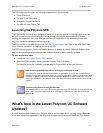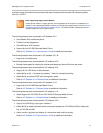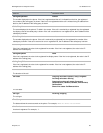
Web Application for Polycom Phones UC Software 5.0.0
Polycom, Inc. 22
If any invalid URI is present in a XHTML file, the execution of that URI is ignored.
For example, Table 7 shows the code created for a link that behaves as if you pressed the Do Not
Disturb key:
Table 7: Sample Code - Simulate Pressing of Do Not Disturb Key
<html>
<body> <br/>
Click on the link to engage the DND feature
<a href="Key:DoNotDisturb">DNDSettings</a>
</body>
<softkey index="1" label="Back" action="SoftKey:Back" />
<softkey index="2" label="Exit" action="SoftKey:Exit" />
</html>
For example, to place a call to *50, and then wait two seconds before entering 44:
Table 8: Sample Code – Pauses in Calls
<html>
<head>
</head>
<body>
<a href="tel:*50;postd=,44">Push to Talk</a>
</body>
</html>
Note: How to Indicate Pauses
A two-second pause is indicated by the comma. A one-second pause is indicated by a p character.
The dual-tone multi-frequency (DTMF) is sent after the placed call is connected. You can use a
combination of both the comma and letter “p” for any amount of time you want to use. These
combinations can also be used in between the digits. For example, postd=pp1,12p8765.
Using Push Requests
A push request is an XML formatted request you send to a phone to tell it to process the XML content.
The phone may render the data, fetch a URL, or perform an action.
See also Configuring Push Request Parameters.


















